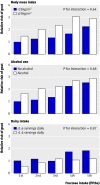Soft drinks, fructose consumption, and the risk of gout in men: prospective cohort study
- PMID: 18244959
- PMCID: PMC2234536
- DOI: 10.1136/bmj.39449.819271.BE
Soft drinks, fructose consumption, and the risk of gout in men: prospective cohort study
Abstract
Objective: To examine the relation between intake of sugar sweetened soft drinks and fructose and the risk of incident gout in men.
Design: Prospective cohort over 12 years.
Setting: Health professionals follow-up study.
Participants: 46 393 men with no history of gout at baseline who provided information on intake of soft drinks and fructose through validated food frequency questionnaires.
Main outcome measure: Incident cases of gout meeting the American College of Rheumatology survey criteria for gout.
Results: During the 12 years of follow-up 755 confirmed incident cases of gout were reported. Increasing intake of sugar sweetened soft drinks was associated with an increasing risk of gout. Compared with consumption of less than one serving of sugar sweetened soft drinks a month the multivariate relative risk of gout for 5-6 servings a week was 1.29 (95% confidence interval 1.00 to 1.68), for one serving a day was 1.45 (1.02 to 2.08), and for two or more servings a day was 1.85 (1.08 to 3.16; P for trend=0.002). Diet soft drinks were not associated with risk of gout (P for trend=0.99). The multivariate relative risk of gout according to increasing fifths of fructose intake were 1.00, 1.29, 1.41, 1.84, and 2.02 (1.49 to 2.75; P for trend <0.001). Other major contributors to fructose intake such as total fruit juice or fructose rich fruits (apples and oranges) were also associated with a higher risk of gout (P values for trend <0.05).
Conclusions: Prospective data suggest that consumption of sugar sweetened soft drinks and fructose is strongly associated with an increased risk of gout in men. Furthermore, fructose rich fruits and fruit juices may also increase the risk. Diet soft drinks were not associated with the risk of gout.
Conflict of interest statement
Competing interests: None declared.
Figures

Comment in
-
Sugary drinks, fruit, and increased risk of gout.BMJ. 2008 Feb 9;336(7639):285-6. doi: 10.1136/bmj.39479.667731.80. BMJ. 2008. PMID: 18258933 Free PMC article.
-
Such sweet sorrow: fructose and the incidence of gout.Curr Rheumatol Rep. 2010 Apr;12(2):77-9. doi: 10.1007/s11926-010-0088-z. Curr Rheumatol Rep. 2010. PMID: 20425014 Clinical Trial. No abstract available.
References
-
- Roubenoff R, Klag MJ, Mead LA, Liang KY, Seidler AJ, Hochberg MC. Incidence and risk factors for gout in white men. JAMA 1991;266:3004-7. - PubMed
-
- Choi HK, Atkinson K, Karlson EW, Willett WC, Curhan G. Purine-rich foods, dairy and protein intake, and the risk of gout in men. N Engl J Med 2004;350:1093-103. - PubMed
-
- Choi HK, Curhan G. Gout: epidemiology and lifestyle choices. Curr Opin Rheumatol 2005;17:341-5. - PubMed
-
- Choi HK, Mount DB, Reginato AM. Pathogenesis of gout. Ann Intern Med 2005;143:499-516. - PubMed
-
- Lawrence RC, Helmick CG, Arnett FC, Deyo RA, Felson DT, Giannini EH, et al. Estimates of the prevalence of arthritis and selected musculoskeletal disorders in the United States. Arthritis Rheum 1998;41:778-99. - PubMed
Publication types
MeSH terms
Substances
Grants and funding
LinkOut - more resources
Full Text Sources
Other Literature Sources
Medical
